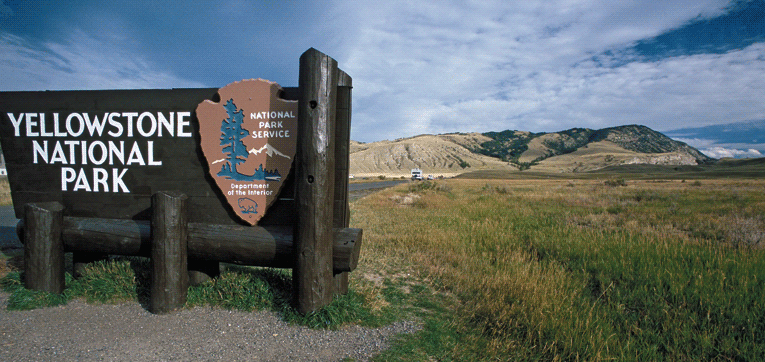
| To state that we have to preserve nature and protect it against degradation seems redundant nowadays. However, people’s awareness of nature was not as strong as ours in the 19th century. In the course of the conquest of the American West, vast territories were simply occupied and forests were regarded as mere wood and log stores, while animals were no more than hunting targets to obtain meat and fur. In other countries, the idea people had about nature was not very different.
The creation of the first Natural Park of the World in 1872— the Yellowstone Park— was crucial for a change in perspective 140 years ago. It was a good idea. The delimitation of the protected area was, indeed, a turning point in the way of understanding nature. One of the things that helped most to the constitution of the park was the circulation of some photographs taken in a geological survey that explored a inhospitable region called Yellowstone by William Henry Jackson in 1870. In the beginning, it was established as a public space for «public benefit, use and enjoyment», but free building construction was banned as well as logging and hunting. A natural park was founded, a pioneer action that influenced environmentalist policies at a global scale. Positive consequences quickly appeared. One of them was that the extinction of bison was stopped. This huge herbivore was the most important animal for the natives, since they fed on their meat, dressed with their fur and made tools with their bones. Such was the bison’s importance for the natives that the government commanded their extermination so as to try to reduce the number of hostile Indian tribes forty years before the institution of the park. When the first Europeans arrived in America, there were sixty million bison. However, over-hunting, colonisation and exploitation of big meadows and the advent of the railway almost led to the extinction of this species, reducing their number to a few hundreds. They were killed for pleasure, as target practice from trains, leaving the bodies laying on the ground after them It was then when the crusade to recover this species started —a small group of bison from Yellowstone, which was already a natural park, grew and, in a short time, not only did they have their future guaranteed within the reserve, but they also helped to repopulate other areas where they had become extinct. In the same way, other species recuperated their original numbers little by little. These measures were quickly imitated by other countries, encouraging the creation of new natural parks all over the planet.
|
«Yellowstone is a huge ecosystem, equal in surface area to the Netherlands, that has made the survival of many species possible. It is also the most visited natural park in the world with more than three million visitors per year» |
|
 © Albert Masó On the left, a herd of bison, hallmark of the park, grazing in the Hayden Valley meadows. They were the protagonists of the first great achievement of the park —at the verge of extinction, a good environmental management got to save the species. On the right, a male elk bells in front of the females near the Garner river, in the Mammoth region. This species, which lives in big herds, reached 100.000 specimens after the extinction of wolves. |
|
|
|
However, as doctor Ramon Margalef warned in his time, we sometimes make the mistake of creating natural parks and, soon afterwards, under the pretext that there is something already being protected, let other areas to be devastated. In addition, the management rules applied at the «Yogi bear’s park» are not free of controversy. The truth is that the management of a park of this size necessarily brings controversial measures, which have sometimes turned out to be counterproductive and needed rectification. For instance, the extinction of wolves in the early 20th century (due to their unjustified bad reputation) meant a spectacular increase in population of some animals like elks, which reached 100.000 specimens. However, the reintroduction of wolves has helped to correct the situation. Another problem was how to face wildfires in the park. At first, all fires were put out, whether naturally produced or not, but that meant leaving the ground completely covered in branches. In 1988, a great deal of the wood accumulated for 90 years was covering the ground of most parts of the park. The fires produced that summer, in June, could not be put out until the first snows of September. Half a million hectares burnt, a 36% of the surface of the park. From then on, fire policy changed —naturally produced fires are let burnt under control because they are now considered a natural way of forest regeneration, and fire is only put out when produced by humans. |
 © Alber Masó Lower Yellowstone Falls is the largest waterfall of the park (94 metres). |
|
 © Albert Masó Wildfires, one of the most controversial problems the park has to face, has left desolate landscapes like this forest by the Madison riverside. (On the left). A deep canyon formed by the Yellowstone river (on the right) reveals the yellowish hue of the mountain range, the reason behind the name of the park. |
«One of the things that helped most to the constitution of the park was the circulation of some photographs taken in a geological survey at Yellowstone by William Henry Jackson in 1870» |
|
|
It is thus a good moment to celebrate what happened in 1872 and make an evaluation, not only of Yellowstone’s 140 years, but of the 140 years of natural park management. This park is not only important because it was the first, but also because it has a great number of assets that make it an outstanding place. It has around 10.000 thermal formations (the largest concentration known), including more than 200 geysers. Located at the heart of the Rocky Mountains, it includes sharp and high peaks, since it is a geologically young mountain range and, therefore, scarcely eroded. The yellowish hue of some of the rocks in the park is the reason behind its name. In its highest parts there are Alpine glaciers traversed by a deep canyon formed by the Yellowstone river, making a waterfall of almost 100 metres of height. It has centennial trees, fossilised trunks, wild waters and a great diversity in minerals of a volcanic origin, like basalt, which can crystallise and become obsidian glass, like the impressive Obsidian Mountain. Together with the Grand Teton National Park and the national forests and wildlife refuges surrounding it, the Yellowstone park is a huge ecosystem equal in surface area to the Netherlands that has made the survival of many species possible. Big pine and fir forests grow in its slopes, as well as big meadows, in which we can see coyotes, deer, grizzly bears, moose, lynxes, white goats… and up to 70 different mammals that are a part of its rich mountain fauna. All of this help us to understand why, aside from being the first one, Yellowstone is also the most visited natural park in the world, with more than three million visitors per year. Hot Origins An extraordinary volcano strongly erupted in the middle if North America 600.000 years ago changing dramatically the landscape surrounding it, forming a 2500 km2 caldera placed at the centre of the park. It is a geothermally active area in which geysers, fumaroles, mud volcanos or hot springs are formed. Some Indian tribes, like the Shoshones and the Bannocks, used to hunt there long before conquistadors arrived. Other tribes thought the place was inhabited by evil spirits because of the amazing geothermal phenomena. When Europeans arrived the landscape remarkably changed and the population of bison, wolves and bears dramatically decreased. |
 © Albert Masó From top to bottom. An elk specimen (Cervus elaphus), runs through the Mammoth forest. The mule deer (Odocoileus hemionus) lives in herds, like this one entering a forests in the main prairie in Yellowstone. A squirrel of the Tamias genus, or chipmunk, laying on rock close to the Gibbon river. |
|
 © Albert Masó The spectacular formation of Minerva terrace (on the left) is the result of mineral deposits that are continually formed by superimposition due to the evaporation of the warm water that comes from under the ground.Fumaroles (on the right) are the most visible manifestation of volcanic activity in the park. Around it, the forests are forced to back away, as in this area of the Norris Geyser Basin. |
||
|
In 1808, John Colter, the first European explorer, described this land as a landscape full of fire craters and boiling water, reason for which it was nicknamed as «Colter’s Hell». The first visitors of the park came attracted by these geothermal wonders, and paid little attention to the amazing virgin landscapes or the rich fauna inhabiting the place. PROTECTED AREA AWARENESS NOWADAYS Of course, one may find downsides to the institution of protected areas. But the few that can be supported are overwhelmingly compensated by its upsides. A natural park is a refuge (sometimes the last one) for many species, which may be irretrievable if they disappear. This situation is not comparable to the one of the few specimens found in zoos or in animal refuges because we need a population large enough to avoid the dangers of consanguinity. Likewise, it preserves whole ecosystems, which is at a higher level than the maintenance of a few species, and enables us to carry out researches on ecology and other branches of biology which, otherwise, might be impossible to carry out. It also facilitates the practical teaching of many aspects of nature and, therefore, raises collective awareness of the need to preserve the area. One can only appreciate and defend what is known. In front of the increasing evidence of the decreasing of biological diversity in our planet, it seems unquestionable that natural parks are reserves of this biodiversity; this way at least we can prevent industrialisation, agriculture, erosion, deforestation, desertification and other factors that seriously alter the environment. Finally, the argument of keeping an aesthetically pleasant environment is also valid. If we have to preserve cathedrals, monuments and other artificial works for its beauty, I don’t see why we shouldn’t preserve a natural spot for the same reasons… even if we were not protecting any endangered species. Ramon Folch’s words, written now more than thirty years ago in «El caso de los espacios naturales protegidos» (Sobre ecologismo y ecología aplicada, 1977) inside the section «Objetos científicos, pedagógicos y estéticos de los espacios naturales protegidos», seem very illustrative and fully in force regarding this issue. Since I can’t improve it I think its better to use his own words: In the current context of environmental degradation, the maintenance of protected areas, more than an advantage is a necessity for scientific research. […] We have to admit that most protected areas join an aesthetic interest to its scientific and pedagogical interests, since they usually are areas provided with the irrefutable charm of harmony. To contribute in preserving the natural beauty of a country is not in the very least a despicable goal. Ramon Folch, 1977 |
 © Albert Masó From top to bottom. A bison (Bison bison) grazes near the meadows by the Gibbon riverside. A coyote (Canis latrans), quietly observes its prey in Alum Creek. And, finally, a group of American white pelicans (Pelecanus erythorhynchos) swimming in a Hayden Valley lagoon. |
|






